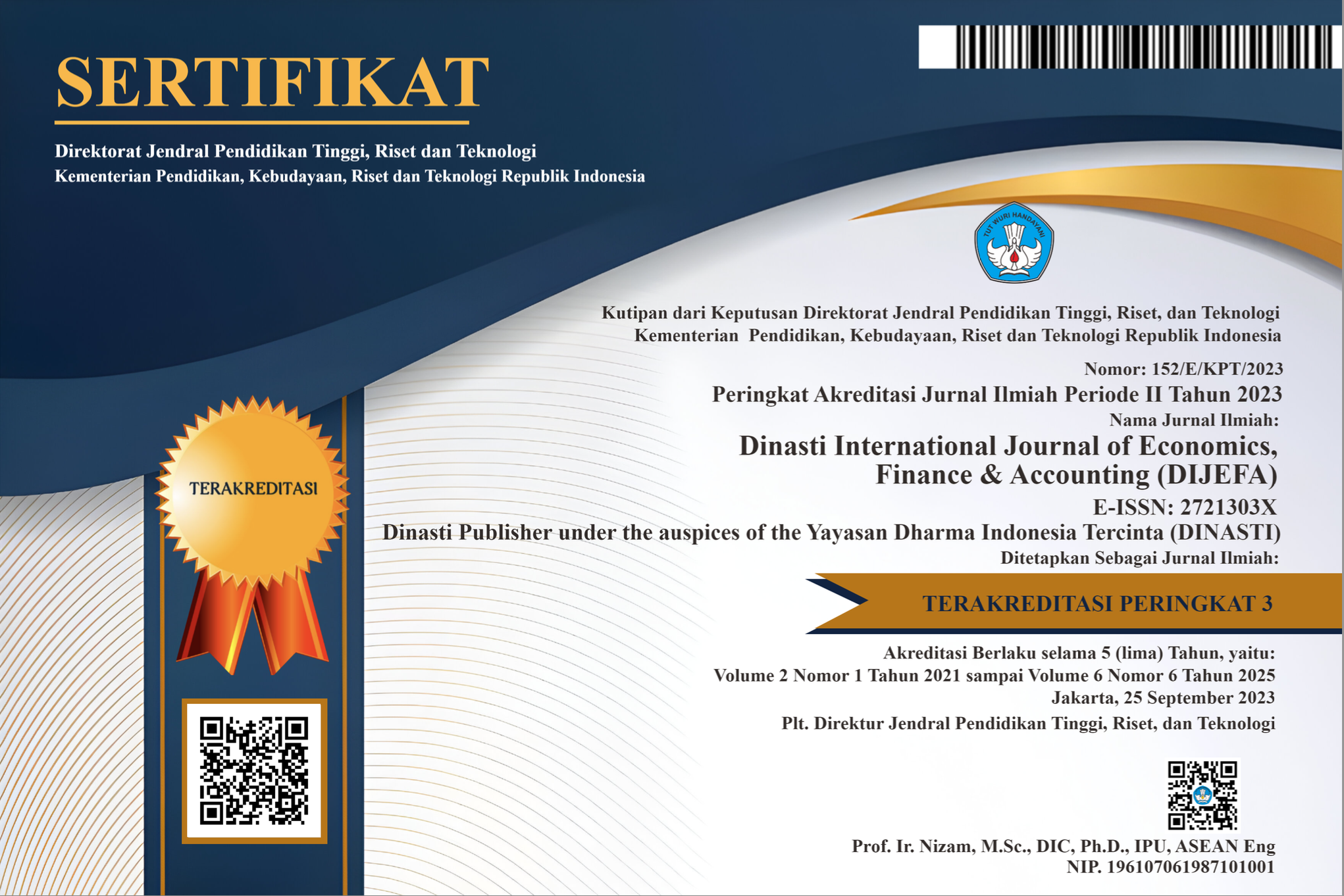Electronic Money Card Service User Loyalty in Payment Transactions: A Study on Generation Z Students
DOI:
https://doi.org/10.38035/dijefa.v6i2.4282Keywords:
Customer Loyalty, Ease Of Transaction, Service Quality, Perceived SecurityAbstract
This study aims to determine factors that influence the quality of service and the loyalty of electronic card service users, particularly in making payment transactions.The study used a quantitative-descriptive research method, collecting primary data from 560 electronic money card users at XYZ University. The sample included 131 users, and the data was analyzed using SmartPLS 3.0. The data was presented as numbers and interpreted into descriptions.This study indicates that: 1) ease of transaction has a positive and significant effect on service quality; 2) ease of transaction has a positive and significant effect on customer loyalty; 3) perceived Security has a positive and significant effect on service quality; 4) perceived security has a positive and significant effect on customer loyalty; 5) service quality has a positive and significant effect on customer loyalty; 6) ease of transaction has a positive and significant effect on customer loyalty through service quality; and 7) perceived security has a positive and significant effect on customer loyalty through service quality.This investigation has the potential to offer novel perspectives on the quality of service and customer loyalty among electronic money card users.
References
Arifin, A. M. N., & Sugiyanto, E. (2020). Disclosing the conduct of using e-money in Semarang city. Journal of Research in Business, Economics, and Education, 2(5), 974–984.
Bank Indonesia. (2019). Bank Indonesia: Navigating the National Payment Systems in Digital Era. Https://Www.Bi.Go.Id/En/Publikasi/Kajian/Documents/Indonesia-Payment-Systems-Blueprint-2025.Pdf, 1–72. Retrieved from www.bi.go.id
Bhalla, R., Tiwari, P., & Chowdhary, N. (2021). Digital Natives Leading the World: Paragons and Values of Generation Z. In N. Stylos, R. Rahimi, B. Okumus, & S. Williams (Eds.), Generation Z Marketing and Management in Tourism and Hospitality: The Future of the Industry (pp. 3–23). Cham: Springer International Publishing. https://doi.org/10.1007/978-3-030-70695-1_1
Bhuiyan, M. R. I., Akter, M. S., & Islam, S. (2024). How does digital payment transform society as a cashless society? An empirical study in the developing economy. Journal of Science and Technology Policy Management, ahead-of-p(ahead-of-print). https://doi.org/10.1108/JSTPM-10-2023-0170
Braun, M. (2023). Research skills modules for further education college based top-up degrees. Research in Education, 00345237231207715. https://doi.org/10.1177/00345237231207715
Chen, T., Guo, W., Gao, X., & Liang, Z. (2021). AI-based self-service technology in public service delivery: User experience and influencing factors. Government Information Quarterly, 38(4), 101520. https://doi.org/https://doi.org/10.1016/j.giq.2020.101520
Choi, K., Wang, Y., Sparks, B. A., & Choi, S. M. (2021). Privacy or security: Does it matter for continued use intention of travel applications? Cornell Hospitality Quarterly, 64(2), 267–282. https://doi.org/10.1177/19389655211066834
Ciptarianto, A. (2022). E-wallet application penetration for financial inclusion in Indonesia. International Journal of Current Science Research and Review, 05(02), 319–332. https://doi.org/10.47191/ijcsrr/v5-i2-03
Fathur, N. P. F., & Cassandra, C. (2023). Why people want To use e-money card based on RFID technology?? 2023 Eighth International Conference on Informatics and Computing (ICIC), 1–5. https://doi.org/10.1109/ICIC60109.2023.10382010
Foster, B., Hurriyati, R., & Johansyah, M. D. (2022). The effect of product knowledge, perceived benefits, and perceptions of risk on Indonesian student decisions to use e-wallets for Warunk Upnormal. Sustainability, Vol. 14. https://doi.org/10.3390/su14116475
Gazi, M. A. I., Mamun, A. Al, Masud, A. Al, Senathirajah, A. R. bin S., & Rahman, T. (2024). The relationship between CRM, knowledge management, organization commitment, customer profitability and customer loyalty in telecommunication industry: The mediating role of customer satisfaction and the moderating role of brand image. Journal of Open Innovation: Technology, Market, and Complexity, 10(1), 100227. https://doi.org/https://doi.org/10.1016/j.joitmc.2024.100227
Guenther, P., Guenther, M., Ringle, C. M., Zaefarian, G., & Cartwright, S. (2023). Improving PLS-SEM use for business marketing research. Industrial Marketing Management, 111(October 2020), 127–142. https://doi.org/10.1016/j.indmarman.2023.03.010
Habib, A., & Hasan, M. M. (2019). Corporate life cycle research in accounting, finance and corporate governance: A survey, and directions for future research. International Review of Financial Analysis, 61, 188–201. https://doi.org/10.1016/j.irfa.2018.12.004
Hassan, M. A., Shukur, Z., & Hasan, M. K. (2021). Electronic Wallet Payment System in Malaysia. In A. Khanna, D. Gupta, Z. Pólkowski, S. Bhattacharyya, & O. Castillo (Eds.), Data Analytics and Management (pp. 711–736). Singapore: Springer Singapore.
Kajol, K., Singh, R., & Paul, J. (2022). Adoption of digital financial transactions: A review of literature and future research agenda. Technological Forecasting and Social Change, 184(September), 121991. https://doi.org/10.1016/j.techfore.2022.121991
Khando, K., Islam, M. S., & Gao, S. (2023). The emerging technologies of digital payments and associated challenges: A systematic literature review. Future Internet, Vol. 15. https://doi.org/10.3390/fi15010021
Kim, L., Wichianrat, K., & Yeo, S. F. (2024). An integrative framework enhancing perceived e-banking service value: A moderating impact of e-banking experience. Journal of Open Innovation: Technology, Market, and Complexity, 10(3), 100336. https://doi.org/https://doi.org/10.1016/j.joitmc.2024.100336
Mashatan, A., Sangari, M. S., & Dehghani, M. (2022). How perceptions of information privacy and security impact consumer trust in crypto-payment: An empirical study. IEEE Access, 10, 69441–69454. https://doi.org/10.1109/ACCESS.2022.3186786
Mulyana, E., Tetep, T., Hamdani, N. A., & Uno, I. C. (2022). Less cash society movement: The impact of using e-money on social changes. Proceedings of the 6th Global Conference on Business, Management, and Entrepreneurship (GCBME 2021), 21–25. Atlantis Press. https://doi.org/10.2991/aebmr.k.220701.006
Munacinga, S. (2021). E-payment instruments and welfare?: the case of Zimbabwe. The Journal for Transdisciplinary Research in Southern Africa, 17(1), 1–11. https://doi.org/10.4102/td.v17i1.823
Nasution, M. I., Fahmi, M., Jufrizen, Muslih, & Prayogi, M. A. (2020). The quality of small and medium enterprises performance using the Structural Equation Model-Part Least Square (SEM-PLS). Journal of Physics: Conference Series, 1477(5), 52052. https://doi.org/10.1088/1742-6596/1477/5/052052
Octabriyantiningtyas, D., Suryani, E., & Jatmiko, A. R. (2019). Modeling Customer Satisfaction with the Service Quality of E-Money in Increasing Profit of PT. Telekomunikasi Indonesia. Procedia Computer Science, 161, 943–950. https://doi.org/https://doi.org/10.1016/j.procs.2019.11.203
Rahayu, S., Rahmatia, Hamrullah, & Junior, A. A. S. (2023). The Demand of E-Money as a Source of Financial Growth. Hasanuddin Review on Sustainable Development, 1(2), 1–19.
Rahmiati, & Susanto, P. (2021). Use behavior of e-money: Empirical analysis using the UTAUT model. Proceedings of the Sixth Padang International Conference On Economics Education, Economics, Business and Management, Accounting and Entrepreneurship (PICEEBA 2020), 398–403. Atlantis Press. https://doi.org/10.2991/aebmr.k.210616.061
Restuputri, D. P., Masudin, I., & Damayanti, A. (2022). The role of usability in business-to-customer digital transactions on multiservice platforms of Indonesian e-money providers. In Digital Transformation Management (1st Editio, p. 21). Routledge, Taylor and Francis Group.
Romero, L. (2024). Value of e-money card transactions in Indonesia from 2017 to 2023(in trillion Indonesian rupiah). Retrieved September 28, 2024, from Finance & Insurance website: https://www.statista.com/statistics/1325996/indonesia-e-money-card-transaction-value/
Sandbukt, S. (2021). Top-Up with Driver Digital Money, Transactional Aspirations, and Peerhood in Yogyakarta, Indonesia (IT-University of Copenhagen). IT-University of Copenhagen. Retrieved from https://pure.itu.dk/portal/files/86283438/PhD_Thesis_final_version_Sunniva_Sandbukt.pdf
Sani, A., Surono, G., Nawaningtyas, P. N., Ivone, M., Wiranata, A. D., & Haryanto, T. (2023). Quick response mobile payment adoption using unified theory of acceptance and use of the technology model development. 2023 11th International Conference on Cyber and IT Service Management (CITSM), 1–5. https://doi.org/10.1109/CITSM60085.2023.10455235
Snyder, H. (2019). Literature review as a research methodology: An overview and guidelines. Journal of Business Research, 104, 333–339. https://doi.org/https://doi.org/10.1016/j.jbusres.2019.07.039
Susanto, P., Hoque, M. E., Hashim, N. M. H. N., Shah, N. U., & Alam, M. N. A. (2022). Moderating effects of perceived risk on the determinants–outcome nexus of e-money behaviour. International Journal of Emerging Markets, 17(2), 530–549. https://doi.org/10.1108/IJOEM-05-2019-0382
Thakkar, J. J. (2020). Structural Equation Modelling: Application for Research and Practice (with AMOS and R). Springer Nature Singapore Pte Ltd. 2020. https://doi.org/https://doi.org/10.1007/978-981-15-3793-6
The World Bank. (2024a). E-Money Competition Issues. Retrieved September 30, 2024, from Inclusive Digital Financial Services website: https://digitalfinance.worldbank.org/topics/e-money-competition-issues
The World Bank. (2024b). E-Money Integrity & Security. Retrieved September 30, 2024, from Inclusive Digital Financial Services website: https://digitalfinance.worldbank.org/topics/e-money-integrity-security
Tulinayo, P., Ssentume, P., & Najjuma, R. (2018). Digital technologies in resource constrained higher institutions of learning: a study on students’ acceptance and usability. International Journal of Educational Technology in Higher Education, 15. https://doi.org/10.1186/s41239-018-0117-y
Vila, T. D., González, E. A., Araújo Vila, N., & Fraiz Brea, J. A. (2021). Indicators of website features in the user experience of e-tourism search and metasearch engines. Journal of Theoretical and Applied Electronic Commerce Research, Vol. 16, pp. 18–36. scielocl.
Viviana, N., & Mulyono, K. B. (2022). Determinants of students e-money intention. Proceedings of the 2nd International Conference of Strategic Issues on Economics, Business and, Education (ICoSIEBE 2021), 315–320. Atlantis Press. https://doi.org/10.2991/aebmr.k.220104.048
Widayat, W., Masudin, I., & Satiti, N. R. (2020). E-money payment: Customers’ adopting factors and the implication for open innovation. Journal of Open Innovation: Technology, Market, and Complexity, Vol. 6. https://doi.org/10.3390/joitmc6030057
Zubareva, S. (2020). Socio-cultural Identity of the Digital Generation in the 21st Century: Cultural and Philosophical Analysis. In Z. Anikina (Ed.), Integrating Engineering Education and Humanities for Global Intercultural Perspectives (pp. 960–968). Cham: Springer International Publishing.
Downloads
Published
How to Cite
Issue
Section
License
Copyright (c) 2025 Olfebri Olfebri, Yuliantini, Ika Utami Yulihapsari, Primadi Candra Susanto

This work is licensed under a Creative Commons Attribution 4.0 International License.
Authors who publish their manuscripts in this journal agree to the following conditions:
- The copyright on each article belongs to the author(s).
- The author acknowledges that the Dinasti International Journal of Economics, Finance & Accounting (DIJEFA) has the right to be the first to publish with a Creative Commons Attribution 4.0 International license (Attribution 4.0 International (CC BY 4.0).
- Authors can submit articles separately, arrange for the non-exclusive distribution of manuscripts that have been published in this journal into other versions (e.g., sent to the author's institutional repository, publication into books, etc.), by acknowledging that the manuscript has been published for the first time in the Dinasti International Journal of Economics, Finance & Accounting (DIJEFA).


























































